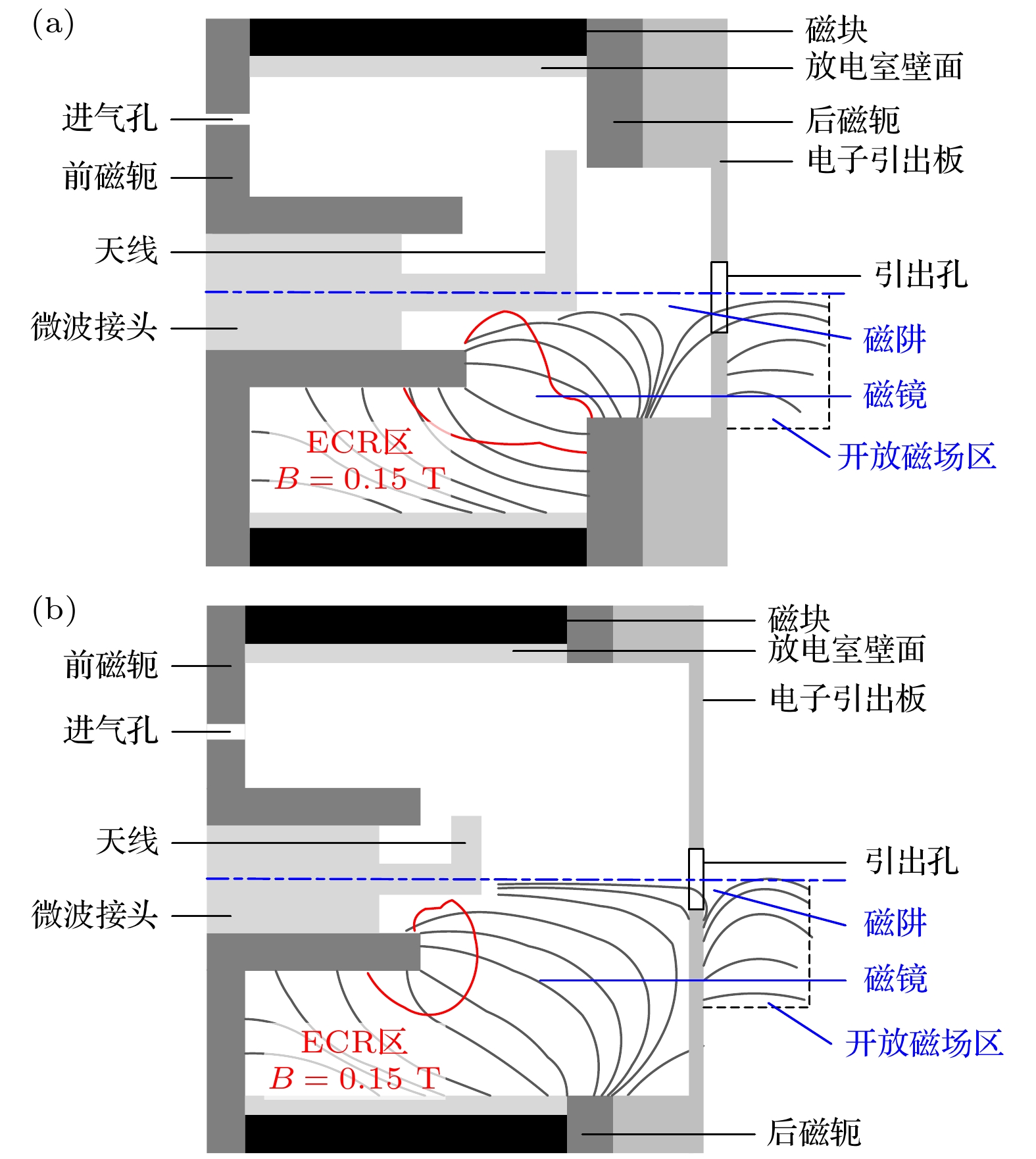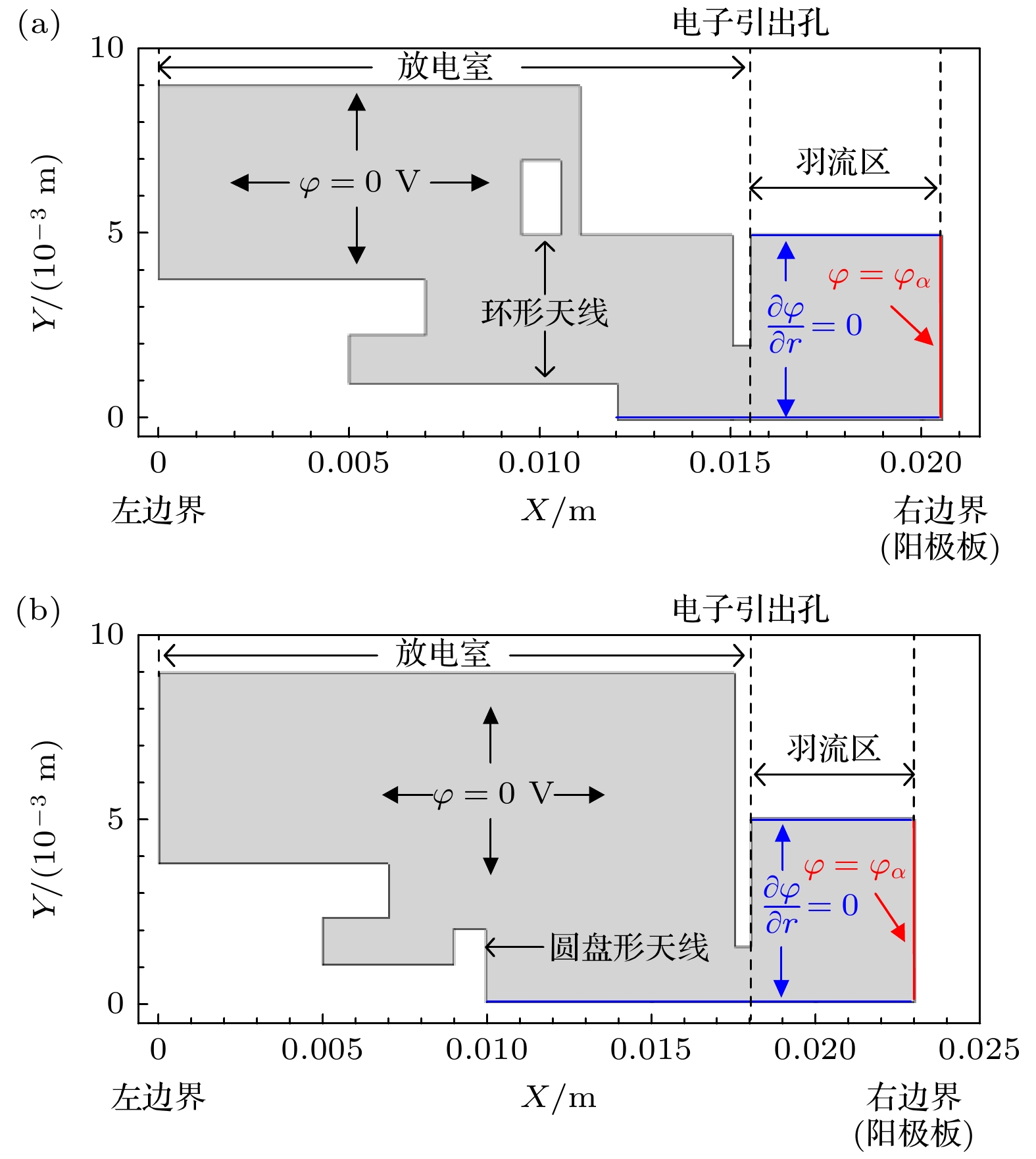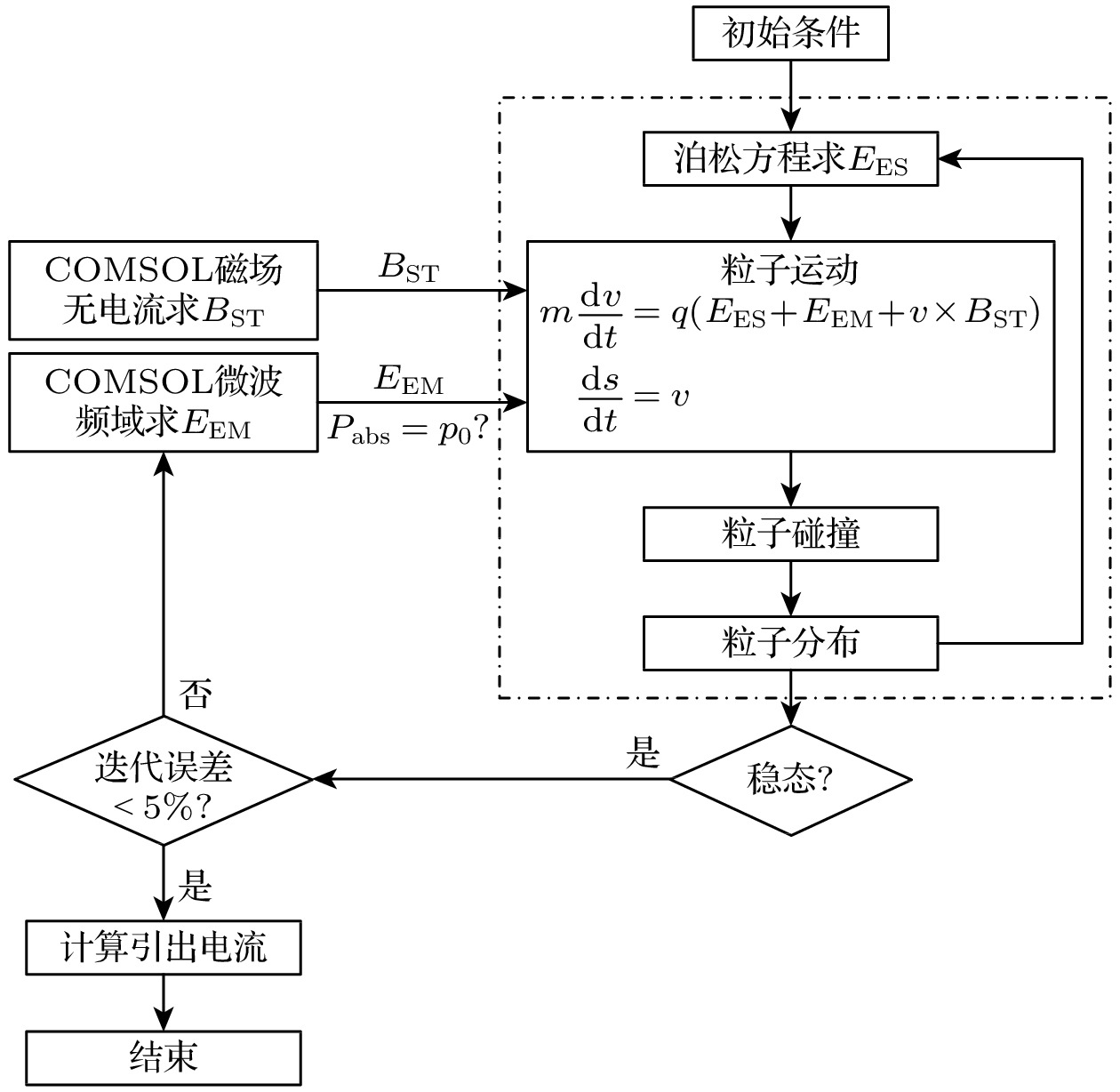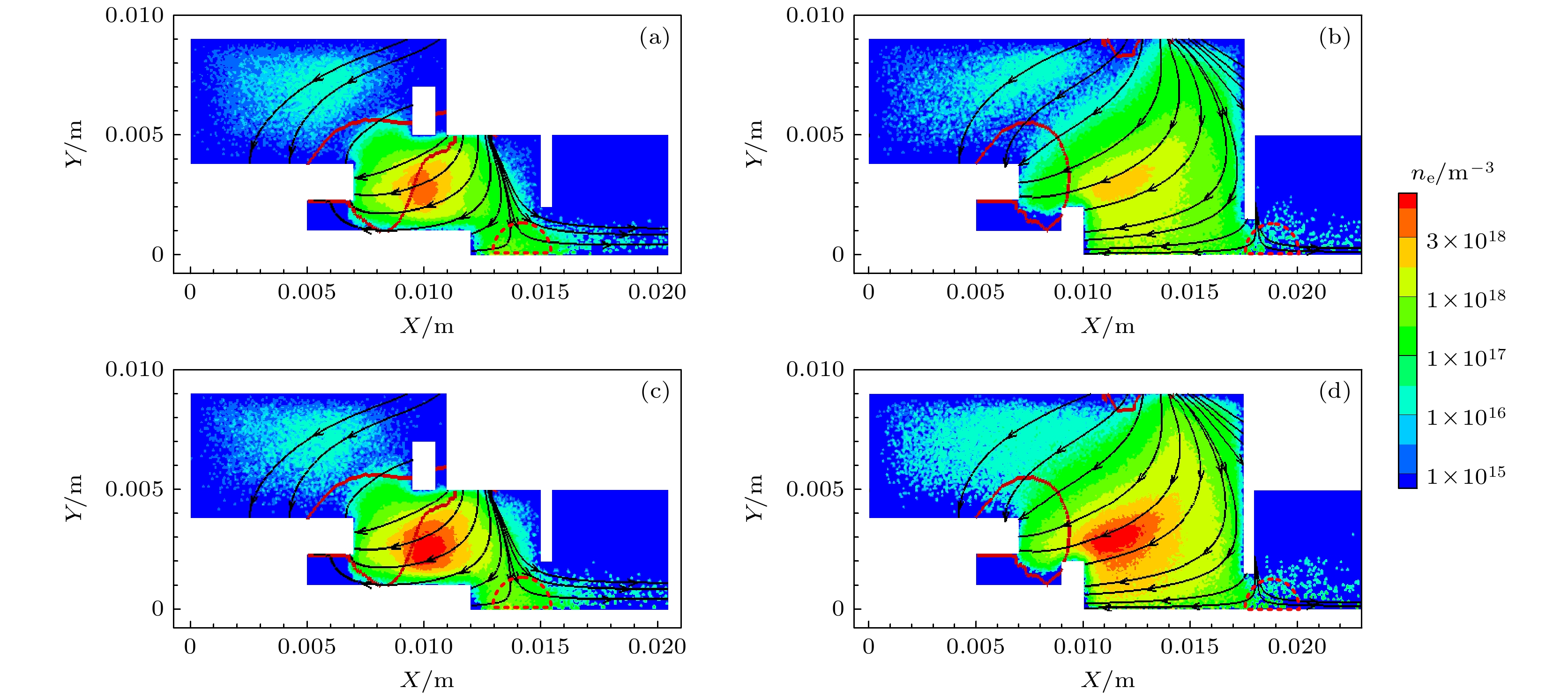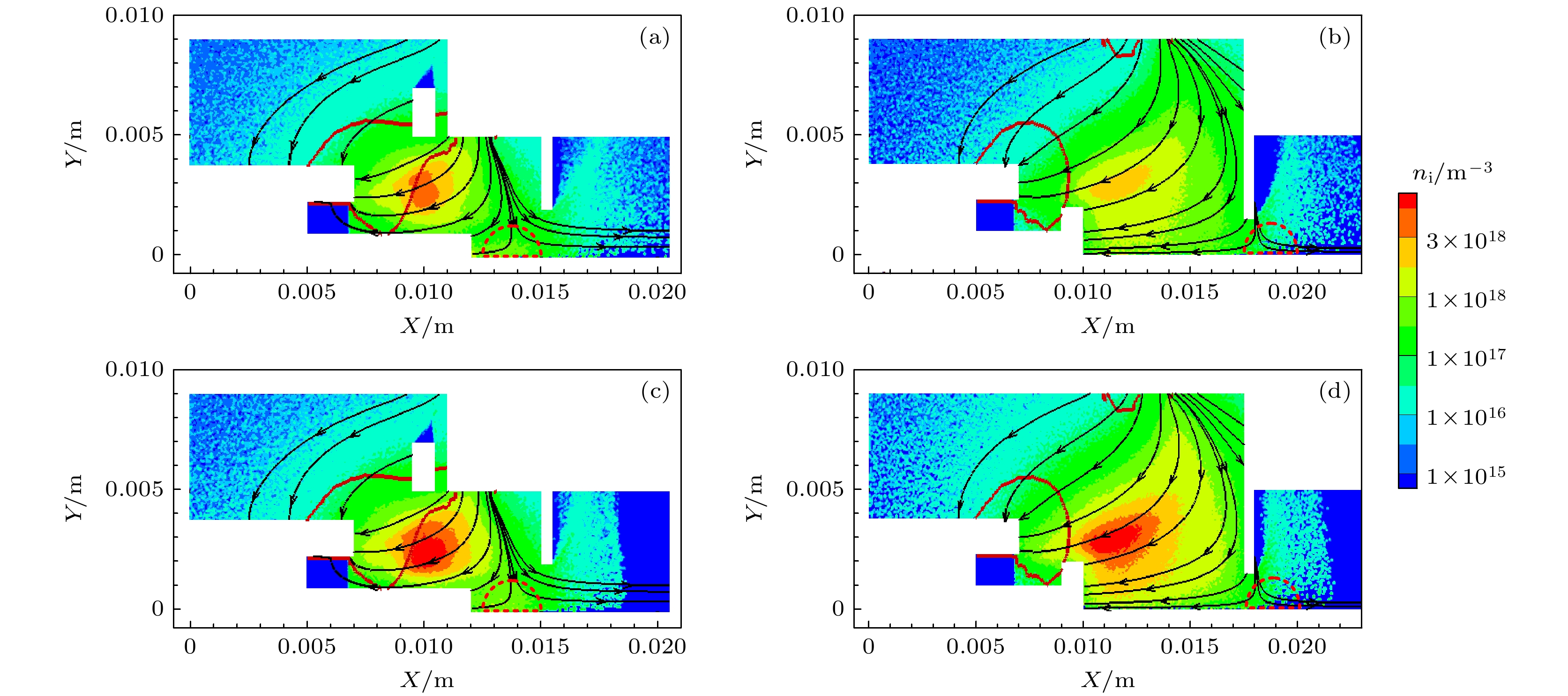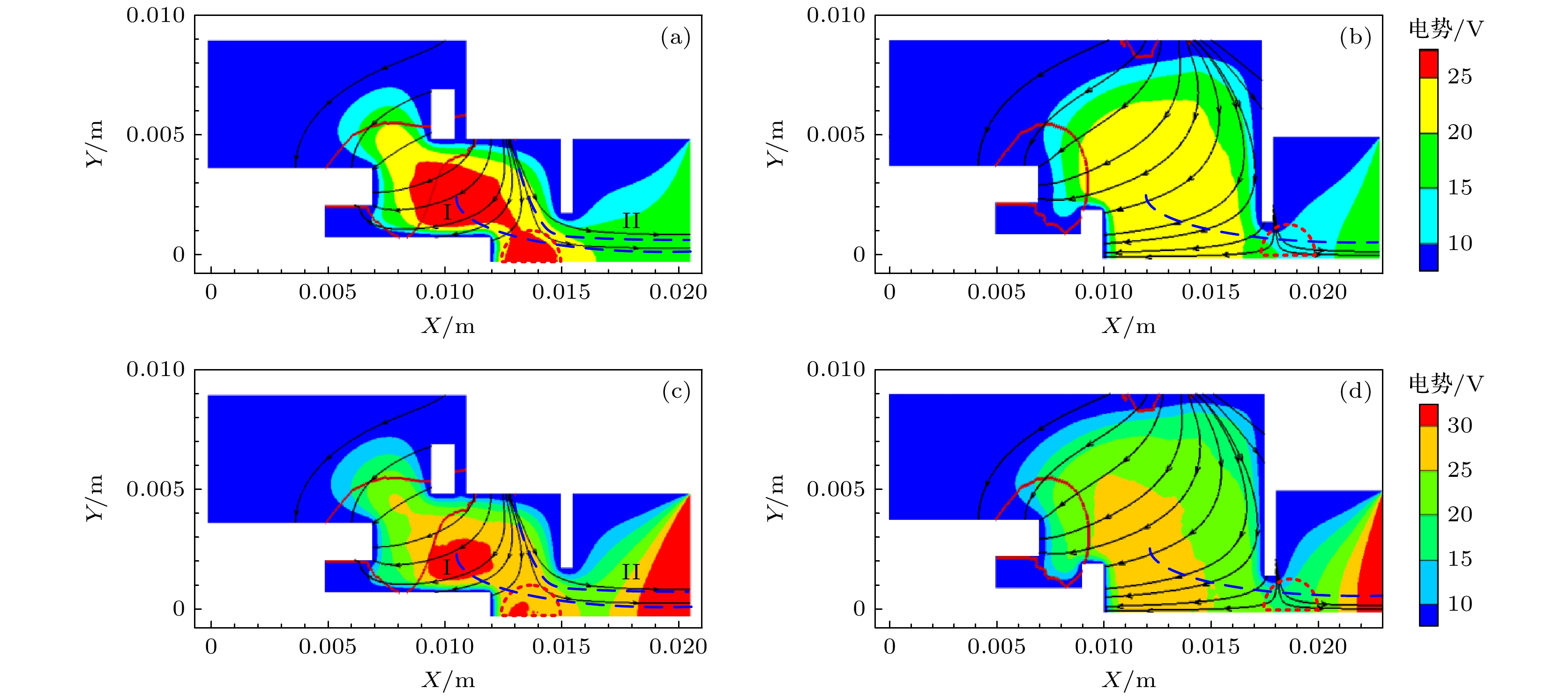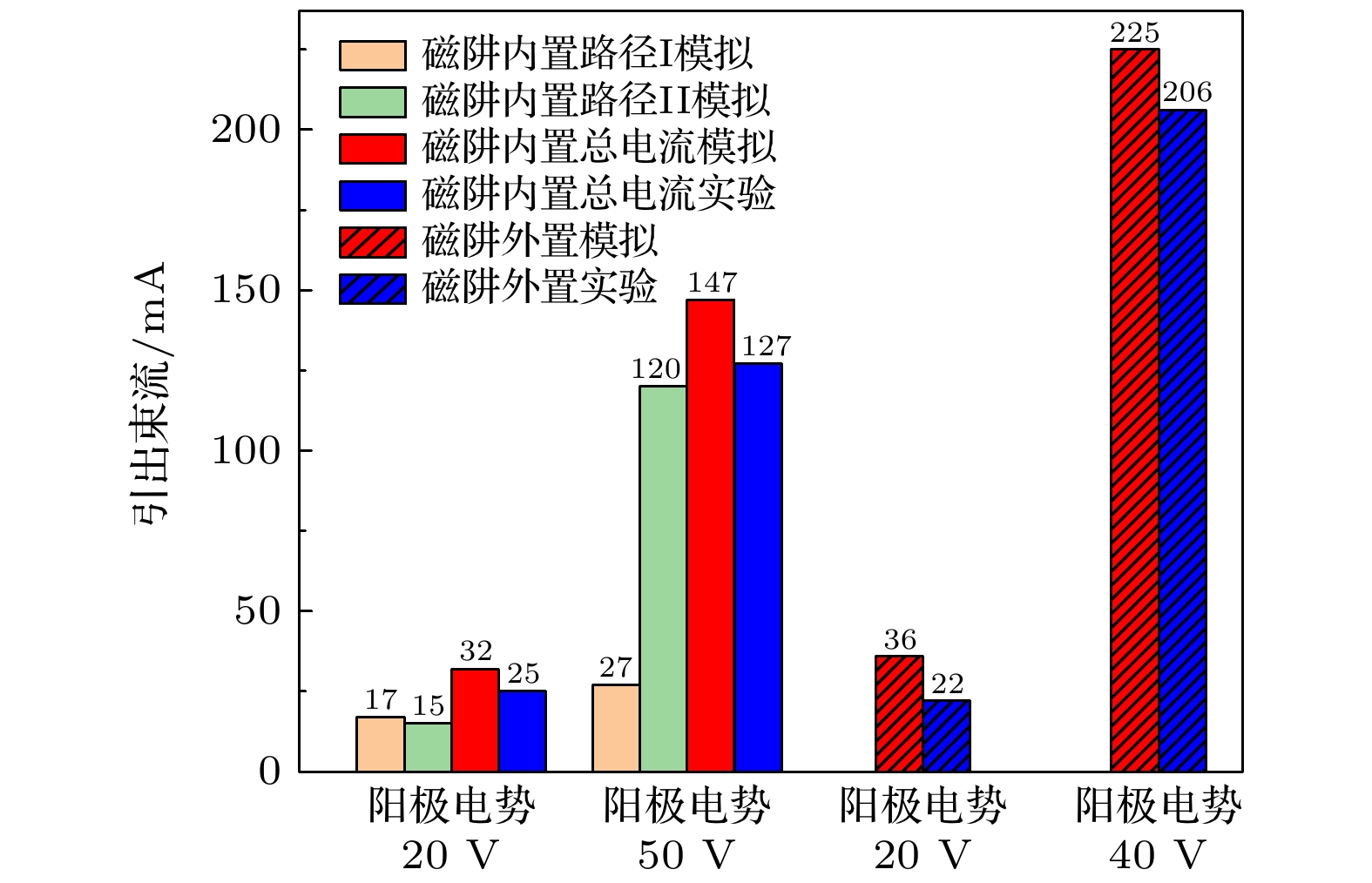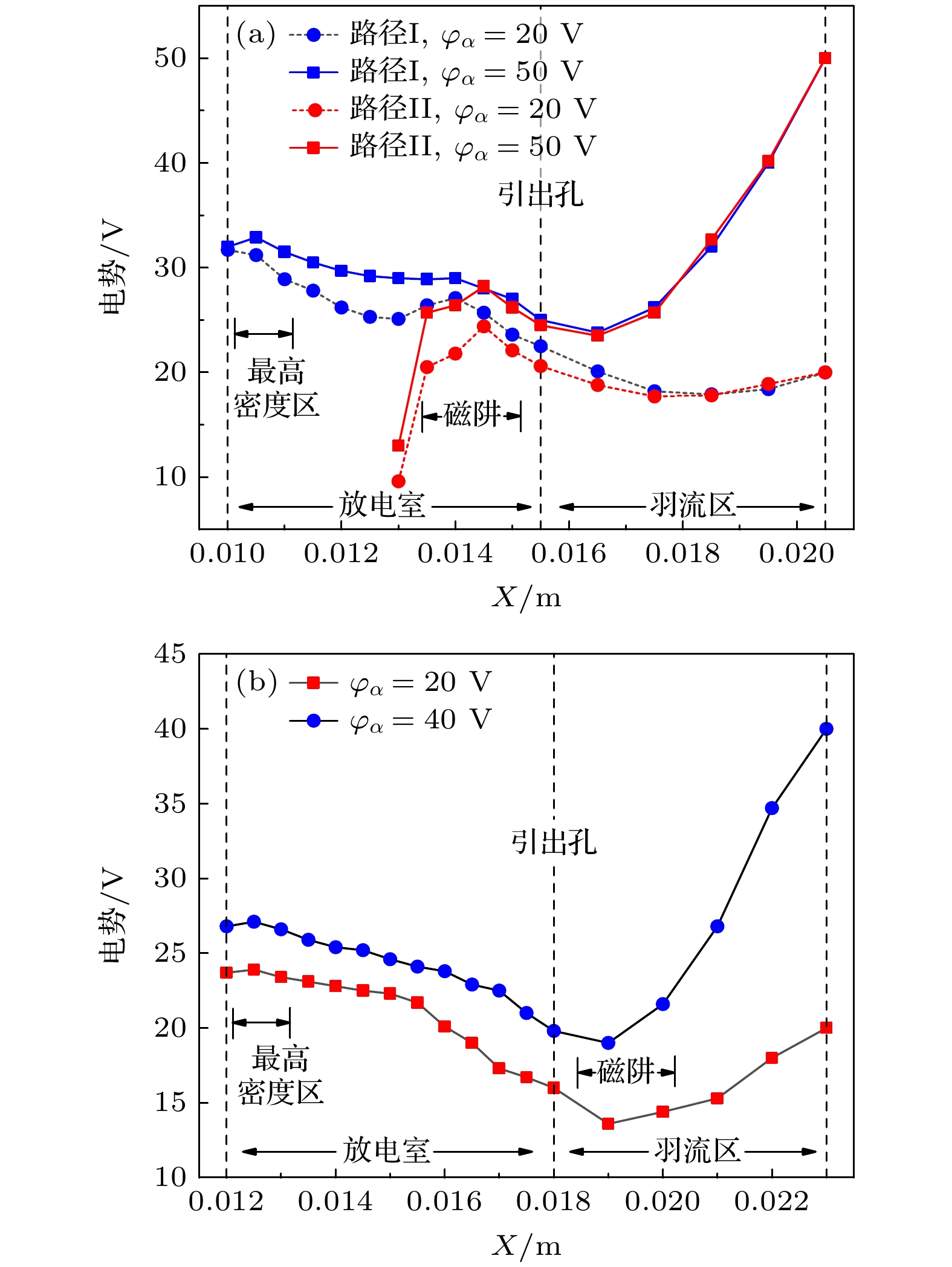-
10 cm电子回旋共振离子推力器(ECRIT)的ECR中和器是关键部件, 其内部磁场是影响中和器性能的重要因素. 磁场的均匀性和磁阱位置是磁场特征的重要表现, 制约等离子体与电势的分布规律、电子引出过程及中和器性能. 本文分别建立磁场均匀性低、磁阱位于电子引出孔上游和磁场均匀性高、磁阱位于电子引出孔下游的ECR中和器PIC/MCC模型, 在给定参数条件下, 开展等离子体和电势分布规律及电子引出过程的数值模拟研究并分析其对中和器性能的影响. 结果表明, 磁场均匀性高、磁阱位于电子引出孔下游时, 中和器内整体电势分布较均匀, 电子容易朝磁阱区迁移, 低引出电势引出高电子束流, 其性能高于磁场均匀性低、磁阱内置的中和器. 研究工作将为发展高性能的ECR中和器奠定重要基础.Electron cyclotron resonance (ECR) neutralizer is a key component of electron cyclotron resonance ion thruster (ECRIT) with a diameter of 10 cm, which plays an important role in maintaining the spacecraft potential balance and neutralizing the ions in the plume region. Optimizing magnetic field distribution is an important way to improve the performance of neutralizer. At the same time, the uniformity of the magnetic field and the position of the magnetic trap can affect the magnetic field characteristics, plasma performance, electron extraction process, and beam current. Previous experimental researches showed that the beam current extraction performances of the two ECR neutralizers with different magnetic field uniformity and different magnetic trap locations are significantly different. However, it is difficult to reveal the physical phenomena and causes only through experiments, so numerical simulation is needed. Therefore PIC/MCC codes for the ECR neutralizers with different uniformity of magnetic field and different positions of magnetic trap are established. Under the given electron extraction potential, numerical simulations are accomplished to study electron extraction procedure and analyze its influence on the performance of the neutralizer. The simulation results show that when the magnetic field uniformity is low and the magnetic trap is located upstream of extraction orifice, the migration of electrons from the magnetic trap to the outlet is limited by the magnetic field and the electric field, thus a higher potential energy is needed to extract the electrons. Otherwise, when the magnetic field uniformity is high and the magnetic trap is located at the downstream of extraction orifice, electrons will be more likely to migrate towards the magnet trap. After the electrons reach the magnetic trap, under the action of the anode potential, the external potential is higher, and the external weak magnetic field almost fails to hold these electrons. Therefore a large number of electrons can be extracted at low extraction potential. This research will lay an important foundation for the development of high-performance ECR neutralizer.
[1] 杨涓, 牟浩, 耿海, 吴先明 2023 推进技术 44 78
 Google Scholar
Google Scholar
Yang J, Mou H, Gen H, Wu X M 2023 J. Propuls. Tech. 44 78
 Google Scholar
Google Scholar
[2] Koizumi H, Komurasaki K, Aoyama J, Yamaguchi K 2018 J. Propuls. Power 34 960
 Google Scholar
Google Scholar
[3] 谈人玮, 杨涓, 耿海, 吴先明, 牟浩 2023 物理学报 72 045202
 Google Scholar
Google Scholar
Tan R W, Yang J, Gen H, Wu X M, Mou H 2023 Acta Phys. Sin. 72 045202
 Google Scholar
Google Scholar
[4] Tsuru T, Kondo S, Yamamoto N, Nakashima H 2009 T. Jpn. Soc. Aeronaut. S. 7 163
 Google Scholar
Google Scholar
[5] Kuninaka H, Nishiyama K, Funaki I, Yamada T, Shimizu Y, Kawaguchi J 2007 J. Propul. Power 23 544
 Google Scholar
Google Scholar
[6] Tsuda Y, Nakazawa S, Yoshikawa M, Saiki T, Terui F, Arakawa M, Abe M, Kitazato K, Sugita S, Tachibana S, Namiki N, Tanaka S, Okada T, Ikeda H, Watanabe S i, Hirabayashi M, Tsuda Y 2022 Hayabusa2 Asteroid Sample Return Mission (Elsevier) pp5–23
[7] Kawaguchi J i, Fujiwara A, Uesugi T 2008 Acta Astronaut. 62 639
 Google Scholar
Google Scholar
[8] Mou H, Jin Y Z, Yang J, Xia X, Fu Y L 2022 Chin. Phys. B 31 075202
 Google Scholar
Google Scholar
[9] Zheng P, Wu J, Zhang Y, Che B, Li J 2021 Acta Astronaut. 187 236
 Google Scholar
Google Scholar
[10] 罗立涛, 杨涓, 金逸舟, 孙俊, 韩飞 2016 中国空间科学技术 36 35
 Google Scholar
Google Scholar
Luo L T, Yang J, Jin Y Z, Sun J, Han F 2016 Chin. Space Sci. Tech. 36 35
 Google Scholar
Google Scholar
[11] 罗立涛, 杨涓, 金逸舟, 冯冰冰, 汤明杰 2015 西北工业大学学报 33 395
 Google Scholar
Google Scholar
Luo L T, Yang J, Jin Y Z, Feng B B, Tang J M 2015 J. Northwest. Polytech. Univ. 33 395
 Google Scholar
Google Scholar
[12] 孟海波, 杨涓, 黄文斌, 夏旭, 付瑜亮, 胡展 2019 宇航学报 40 1478
 Google Scholar
Google Scholar
Meng H B, Yang J, Huang W B, Xia X, Fu Y L, Hu Z 2019 J. Astronaut. 40 1478
 Google Scholar
Google Scholar
[13] Masui H, Tashiro Y, Yamamoto N, Nakashima H, Funaki I 2006 T. Jpn. Soc. Aeronaut. S. 49 87
 Google Scholar
Google Scholar
[14] Fu Y L, Yang J, Geng H, Wu X, Hu Z, Xia X 2021 Vacuum 184 109932
 Google Scholar
Google Scholar
[15] 高振业 2022 硕士学位论文(西安: 西北工业大学)
Gao Z Y 2022 M. S. Thesis (Xi’an: Northwestern Polytechnical University
[16] Nishiyama K, Kuninaka H 2008 Surf. Coat. Tech. 202 5262
 Google Scholar
Google Scholar
[17] Fu Y L, Yang J, Jin Y, Xia X, Meng H B 2019 Acta Astronaut. 164 387
 Google Scholar
Google Scholar
[18] 付瑜亮 2022 博士学位论文 (西安: 西北工业大学)
Fu Y L 2022 Ph. D. Dissertationn (Xi’an: Northwestern Polytechnical University
[19] 杨涓, 石峰, 杨铁链, 孟志强 2010 物理学报 59 8701
 Google Scholar
Google Scholar
Yang J, Shi F, Yang T L, Meng Z Q 2010 Acta Phys. Sin. 59 8701
 Google Scholar
Google Scholar
[20] 金逸舟 2018 博士学位论文(西安: 西北工业大学)
Jin Y Z 2018 Ph. D. Dissertationn (Xi’an: Northwestern Polytechnical University
[21] Ikkoh Funaki I F, Hitoshi Kuninaka H K 2001 Japanese Journal of Applied Physics 40 2495
 Google Scholar
Google Scholar
[22] 夏旭, 杨涓, 耿海, 吴先明, 付瑜亮, 牟浩, 谈人玮 2022 物理学报 71 045201
 Google Scholar
Google Scholar
Xia X, Yang J, Gen H, Wu X M, Fu Y L, Mou H, Tan R W 2022 Acta Phys. Sin. 71 045201
 Google Scholar
Google Scholar
[23] Chen F F 1974 Introduction to Plasma Physics (New York: Springer Science Business Media) pp139–180
-
图 6 不同阳极电势中和器电子密度分布 (a) 磁阱内置φa = 20 V; (b) 磁阱外置φa = 20 V; (c) 磁阱内置φa = 50 V; (d) 磁阱外置φa = 40 V
Fig. 6. Electron density distribution inside of neutralizer at different anode potential: (a) Internal magnetic trap at φa = 20 V; (b) external magnetic trap at φa = 20 V; (c) internal magnetic trap at φa = 50 V; (d) external magnetic trap at φa = 40 V.
图 7 不同阳极电势中和器离子密度分布 (a) 磁阱内置φa = 20 V; (b) 磁阱外置φa = 20 V; (c) 磁阱内置φa = 50 V; (d) 磁阱外置φa=40 V
Fig. 7. Ion density distribution inside of neutralizer at different anode potential: (a) Internal magnetic trap at φa = 20 V; (b) external magnetic trap at φa = 20 V; (c) internal magnetic trap at φa = 50 V; (d) external magnetic trap at φa = 40 V.
图 9 不同阳极板电势下中和器电势分布 (a) 磁阱内置φa = 20 V; (b) 磁阱外置φa = 20 V; (c) 磁阱内置φa = 50 V; (d) 磁阱外置φa = 40 V
Fig. 9. Potential distribution inside of neutralizer at different anode potential: (a) Internal magnetic trap at φa = 20 V; (b) external magnetic trap at φa = 20 V; (c) internal magnetic trap at φa = 50 V; (d) external magnetic trap at φa = 40 V.
-
[1] 杨涓, 牟浩, 耿海, 吴先明 2023 推进技术 44 78
 Google Scholar
Google Scholar
Yang J, Mou H, Gen H, Wu X M 2023 J. Propuls. Tech. 44 78
 Google Scholar
Google Scholar
[2] Koizumi H, Komurasaki K, Aoyama J, Yamaguchi K 2018 J. Propuls. Power 34 960
 Google Scholar
Google Scholar
[3] 谈人玮, 杨涓, 耿海, 吴先明, 牟浩 2023 物理学报 72 045202
 Google Scholar
Google Scholar
Tan R W, Yang J, Gen H, Wu X M, Mou H 2023 Acta Phys. Sin. 72 045202
 Google Scholar
Google Scholar
[4] Tsuru T, Kondo S, Yamamoto N, Nakashima H 2009 T. Jpn. Soc. Aeronaut. S. 7 163
 Google Scholar
Google Scholar
[5] Kuninaka H, Nishiyama K, Funaki I, Yamada T, Shimizu Y, Kawaguchi J 2007 J. Propul. Power 23 544
 Google Scholar
Google Scholar
[6] Tsuda Y, Nakazawa S, Yoshikawa M, Saiki T, Terui F, Arakawa M, Abe M, Kitazato K, Sugita S, Tachibana S, Namiki N, Tanaka S, Okada T, Ikeda H, Watanabe S i, Hirabayashi M, Tsuda Y 2022 Hayabusa2 Asteroid Sample Return Mission (Elsevier) pp5–23
[7] Kawaguchi J i, Fujiwara A, Uesugi T 2008 Acta Astronaut. 62 639
 Google Scholar
Google Scholar
[8] Mou H, Jin Y Z, Yang J, Xia X, Fu Y L 2022 Chin. Phys. B 31 075202
 Google Scholar
Google Scholar
[9] Zheng P, Wu J, Zhang Y, Che B, Li J 2021 Acta Astronaut. 187 236
 Google Scholar
Google Scholar
[10] 罗立涛, 杨涓, 金逸舟, 孙俊, 韩飞 2016 中国空间科学技术 36 35
 Google Scholar
Google Scholar
Luo L T, Yang J, Jin Y Z, Sun J, Han F 2016 Chin. Space Sci. Tech. 36 35
 Google Scholar
Google Scholar
[11] 罗立涛, 杨涓, 金逸舟, 冯冰冰, 汤明杰 2015 西北工业大学学报 33 395
 Google Scholar
Google Scholar
Luo L T, Yang J, Jin Y Z, Feng B B, Tang J M 2015 J. Northwest. Polytech. Univ. 33 395
 Google Scholar
Google Scholar
[12] 孟海波, 杨涓, 黄文斌, 夏旭, 付瑜亮, 胡展 2019 宇航学报 40 1478
 Google Scholar
Google Scholar
Meng H B, Yang J, Huang W B, Xia X, Fu Y L, Hu Z 2019 J. Astronaut. 40 1478
 Google Scholar
Google Scholar
[13] Masui H, Tashiro Y, Yamamoto N, Nakashima H, Funaki I 2006 T. Jpn. Soc. Aeronaut. S. 49 87
 Google Scholar
Google Scholar
[14] Fu Y L, Yang J, Geng H, Wu X, Hu Z, Xia X 2021 Vacuum 184 109932
 Google Scholar
Google Scholar
[15] 高振业 2022 硕士学位论文(西安: 西北工业大学)
Gao Z Y 2022 M. S. Thesis (Xi’an: Northwestern Polytechnical University
[16] Nishiyama K, Kuninaka H 2008 Surf. Coat. Tech. 202 5262
 Google Scholar
Google Scholar
[17] Fu Y L, Yang J, Jin Y, Xia X, Meng H B 2019 Acta Astronaut. 164 387
 Google Scholar
Google Scholar
[18] 付瑜亮 2022 博士学位论文 (西安: 西北工业大学)
Fu Y L 2022 Ph. D. Dissertationn (Xi’an: Northwestern Polytechnical University
[19] 杨涓, 石峰, 杨铁链, 孟志强 2010 物理学报 59 8701
 Google Scholar
Google Scholar
Yang J, Shi F, Yang T L, Meng Z Q 2010 Acta Phys. Sin. 59 8701
 Google Scholar
Google Scholar
[20] 金逸舟 2018 博士学位论文(西安: 西北工业大学)
Jin Y Z 2018 Ph. D. Dissertationn (Xi’an: Northwestern Polytechnical University
[21] Ikkoh Funaki I F, Hitoshi Kuninaka H K 2001 Japanese Journal of Applied Physics 40 2495
 Google Scholar
Google Scholar
[22] 夏旭, 杨涓, 耿海, 吴先明, 付瑜亮, 牟浩, 谈人玮 2022 物理学报 71 045201
 Google Scholar
Google Scholar
Xia X, Yang J, Gen H, Wu X M, Fu Y L, Mou H, Tan R W 2022 Acta Phys. Sin. 71 045201
 Google Scholar
Google Scholar
[23] Chen F F 1974 Introduction to Plasma Physics (New York: Springer Science Business Media) pp139–180
计量
- 文章访问数: 3817
- PDF下载量: 80
- 被引次数: 0













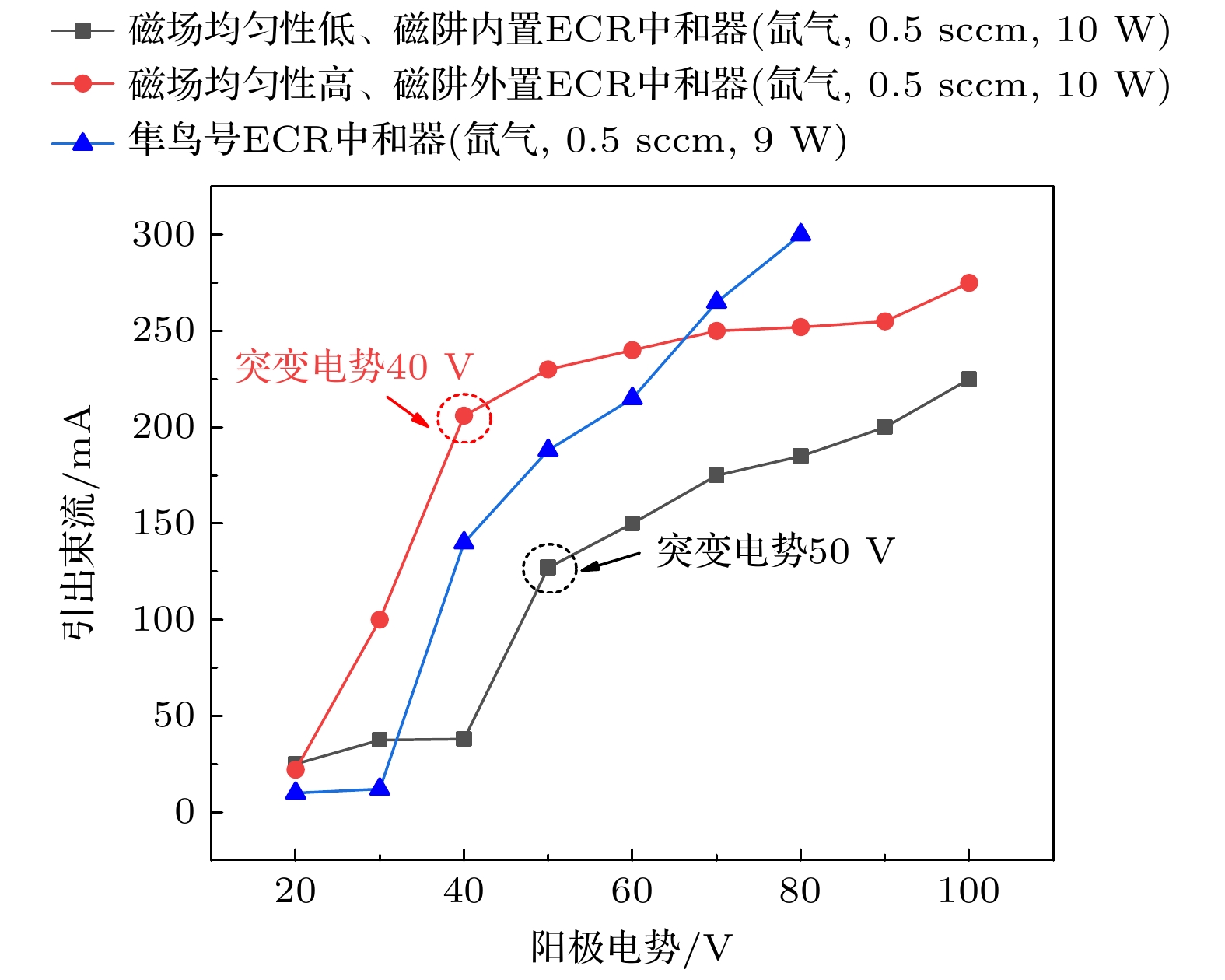
 下载:
下载:
